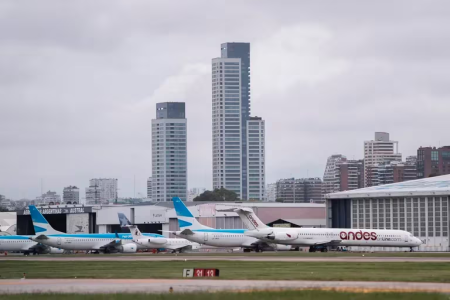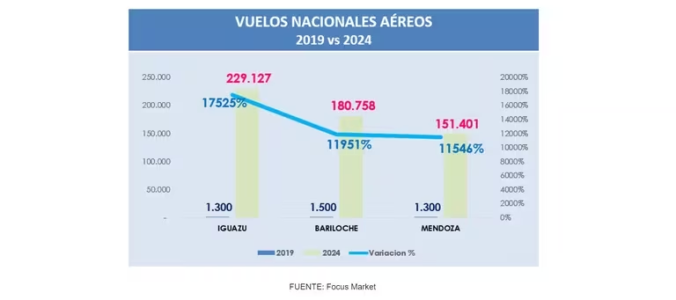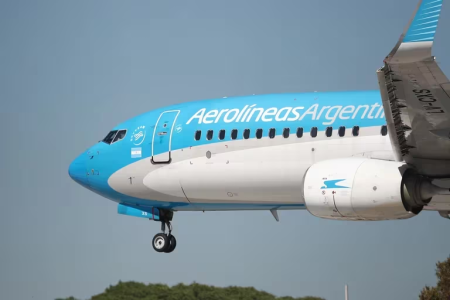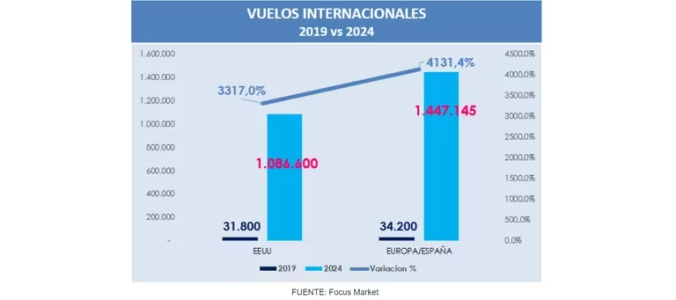turtle
New member
Domestic flights increased up to 17,500% in just five years - Infobae

Source:

 www.infobae.com
www.infobae.com
February 21, 2024
While flight prices accumulated an increase exponentially higher than the accumulated inflation since 2019, outbound and inbound tourism fell.

In 2019, a flight to Miami, United States cost $31,800 (USD 530) and today it amounts to $1,086,600 (USD 815). EFE/ Juan Ignacio Roncoroni/Archive
In the last 5 years, domestic flights had an increase of up to 17,525% , while in that same period the accumulated inflation was 2,134% . Among the causes of the huge increase is the devaluation of the peso, which several low cost companies stopped operating in the country and the increase in taxes, according to a report by Focus Market .
In detail, in 2019 a flight from Buenos Aires to Iguazú had a cost of $1,300, while today that value increased to $229,127, that is, an increase of 17,525% in just 5 years. In the case of Bariloche we will see that the price went from paying a price of $1,500 to $180,758 in 2019, thus showing an increase of 11,951%.
Regarding international flights, in the case of a trip to Miami, United States, the value of the ticket in 2019 was $31,800 (USD 530) and today in 2024 this value is $1,086,600 (USD 815), showing an increase of 3,317%. Meanwhile, a flight to Madrid that in 2019 had a value of $34,200, currently costs $1,447,145 (USD 1071), which represents an increase of 4,131%.

According to Damián Di Pace , director of Focus Market, the causes of these increases are that several low cost companies stopped operating in Argentina, which is why the level of competition was precisely reduced; to the increase in taxes during that period since there were certain routes where the only option was Aerolíneas Argentinas .
“At the same time, international airlines left in the middle of the pandemic, and in many cases, Argentines have to go through Chile or San Pablo to be able to take their flight. Then the cost and flight time also increased,” indicated the economist.
For her part, Paula Cristi , General Manager of Despegar for Argentina and Uruguay, said that to have a real appreciation of the increase in tickets on domestic flights over the years it would have to be done in dollars, since all prices in the industry They are calculated internationally in that currency. Aviation costs (also domestic aviation) are dollarized by leasing and fuel costs.
“Industry prices have always been dynamic for different reasons; depending on the availability of our suppliers, the occupancy factor, seasonality, type of service, purchase anticipation, average stay, etc,” he assured.
“In addition, post-pandemic, the International Air Transport Association (IATA) stated that air tickets have increased in recent years due to the high price of fuel since it is inevitable that this will not impact tickets,” Cristi added.

Tourism represents almost 9% of GDP in Argentina. EFE/Juan Ignacio Roncoroni
“Finally, the tax burden on air tickets in Argentina exceeds the world average and discourages Argentines from traveling,” he concluded.
On the other hand, Di Pace highlighted: “Tourism has a very important impact in contributing to our gross domestic product. In the plan for the economic recovery of our country, the tourism sector is the one that needs to improve connectivity and optimize the use of public resources, due to all the vertical chains it generates. Promoting private initiatives throughout the private services sector (hotels, transportation, guides, gastronomy, among others) can provide genuine jobs.”
“Tourism represents almost 9% of GDP in Argentina and could grow if policies that encourage air connectivity are carried out to expand the diversification of the incoming market in our country. In turn, Argentina needs to design better services and transportation needs that respond to the needs of tourists. The entire hotel and gastronomic agglomerate. Agencies providing tourism services respond with increased investment when they have the predictability of greater investment and infrastructure for the development and promotion of different national destinations,” he added.

Likewise, the economist highlighted that since December, with the 118% devaluation and the increase in fuel, prices have skyrocketed.
In the case of incoming tourism by air, in the accumulated number of 2019, 2,761 tourists entered the country, and in 2023, the entry was 2,478, which represents a drop of 10.24%. "That is, despite having a very competitive exchange rate for foreign tourism, having the contribution of the Argentine destination as tourism for winning the World Cup, Messi as a global brand, and promoting the different destinations to throughout our country, we cannot take advantage of a unique opportunity for the sector,” the report noted.
Regarding outbound tourism, in 2019, 3,707 Argentines left through our international airports and in 2023, 2,782. That is, there was a drop of 24.96% less than in 2019.
“Argentina has lost strong air connectivity with the world after the departure of more than a dozen airlines that decided to reduce their flight frequencies, or worse yet, leave them,” they indicated from Focus Market.

Source:

Los vuelos de cabotaje aumentaron hasta 17.500% en sólo cinco años
Mientras que los precios de los vuelos acumularon una suba exponencialmente superior a la inflación acumulada desde 2019, el turismo emisivo y receptivo cayó.
February 21, 2024
While flight prices accumulated an increase exponentially higher than the accumulated inflation since 2019, outbound and inbound tourism fell.

In 2019, a flight to Miami, United States cost $31,800 (USD 530) and today it amounts to $1,086,600 (USD 815). EFE/ Juan Ignacio Roncoroni/Archive
In the last 5 years, domestic flights had an increase of up to 17,525% , while in that same period the accumulated inflation was 2,134% . Among the causes of the huge increase is the devaluation of the peso, which several low cost companies stopped operating in the country and the increase in taxes, according to a report by Focus Market .
In detail, in 2019 a flight from Buenos Aires to Iguazú had a cost of $1,300, while today that value increased to $229,127, that is, an increase of 17,525% in just 5 years. In the case of Bariloche we will see that the price went from paying a price of $1,500 to $180,758 in 2019, thus showing an increase of 11,951%.
Regarding international flights, in the case of a trip to Miami, United States, the value of the ticket in 2019 was $31,800 (USD 530) and today in 2024 this value is $1,086,600 (USD 815), showing an increase of 3,317%. Meanwhile, a flight to Madrid that in 2019 had a value of $34,200, currently costs $1,447,145 (USD 1071), which represents an increase of 4,131%.

According to Damián Di Pace , director of Focus Market, the causes of these increases are that several low cost companies stopped operating in Argentina, which is why the level of competition was precisely reduced; to the increase in taxes during that period since there were certain routes where the only option was Aerolíneas Argentinas .
“At the same time, international airlines left in the middle of the pandemic, and in many cases, Argentines have to go through Chile or San Pablo to be able to take their flight. Then the cost and flight time also increased,” indicated the economist.
For her part, Paula Cristi , General Manager of Despegar for Argentina and Uruguay, said that to have a real appreciation of the increase in tickets on domestic flights over the years it would have to be done in dollars, since all prices in the industry They are calculated internationally in that currency. Aviation costs (also domestic aviation) are dollarized by leasing and fuel costs.
“Industry prices have always been dynamic for different reasons; depending on the availability of our suppliers, the occupancy factor, seasonality, type of service, purchase anticipation, average stay, etc,” he assured.
“In addition, post-pandemic, the International Air Transport Association (IATA) stated that air tickets have increased in recent years due to the high price of fuel since it is inevitable that this will not impact tickets,” Cristi added.

Tourism represents almost 9% of GDP in Argentina. EFE/Juan Ignacio Roncoroni
“Finally, the tax burden on air tickets in Argentina exceeds the world average and discourages Argentines from traveling,” he concluded.
On the other hand, Di Pace highlighted: “Tourism has a very important impact in contributing to our gross domestic product. In the plan for the economic recovery of our country, the tourism sector is the one that needs to improve connectivity and optimize the use of public resources, due to all the vertical chains it generates. Promoting private initiatives throughout the private services sector (hotels, transportation, guides, gastronomy, among others) can provide genuine jobs.”
“Tourism represents almost 9% of GDP in Argentina and could grow if policies that encourage air connectivity are carried out to expand the diversification of the incoming market in our country. In turn, Argentina needs to design better services and transportation needs that respond to the needs of tourists. The entire hotel and gastronomic agglomerate. Agencies providing tourism services respond with increased investment when they have the predictability of greater investment and infrastructure for the development and promotion of different national destinations,” he added.

Likewise, the economist highlighted that since December, with the 118% devaluation and the increase in fuel, prices have skyrocketed.
Evolution of tourism in the last 4 years
Focus Market took some indicators regarding the year 2019 compared to 2023 with the objective of evaluating its evolution in the last 4 years and post-pandemic.In the case of incoming tourism by air, in the accumulated number of 2019, 2,761 tourists entered the country, and in 2023, the entry was 2,478, which represents a drop of 10.24%. "That is, despite having a very competitive exchange rate for foreign tourism, having the contribution of the Argentine destination as tourism for winning the World Cup, Messi as a global brand, and promoting the different destinations to throughout our country, we cannot take advantage of a unique opportunity for the sector,” the report noted.
Regarding outbound tourism, in 2019, 3,707 Argentines left through our international airports and in 2023, 2,782. That is, there was a drop of 24.96% less than in 2019.
“Argentina has lost strong air connectivity with the world after the departure of more than a dozen airlines that decided to reduce their flight frequencies, or worse yet, leave them,” they indicated from Focus Market.

